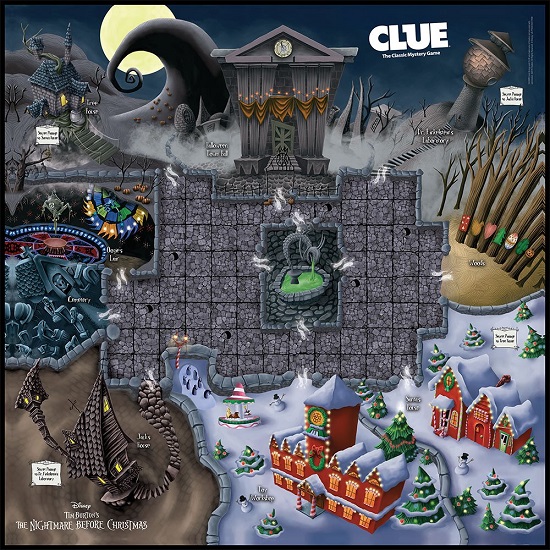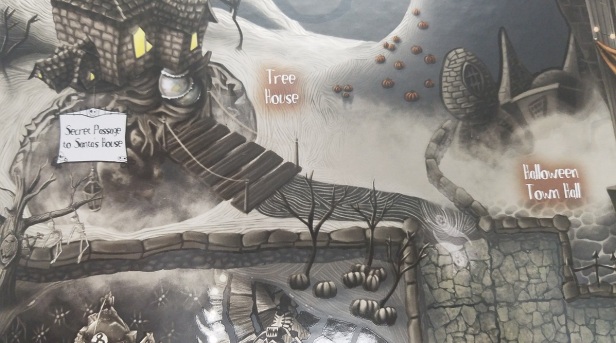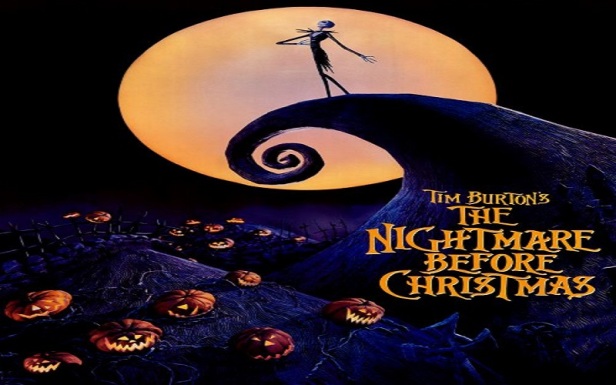Much like every other reasonably successful brand or franchise, Tim Burton’s The Nightmare Before Christmas has been licensed for a series of board games in recent years. Actually, the film has been licensed for an insane amount of merchandise, but let’s just focus on board games for right now. Among those game releases were a card game, a film-themed version of Monopoly, and even a themed version of Parker Brother’s (now Hasbro’s) legendary game of sleuthing, Clue. The game was released by USAopoly in 2016 in a standard-release crimson boxed version, as well as a Hot Topic-exclusive Black Box variant. Horror fans may also be interested in knowing that USAopoly has also released games based on The Walking Dead, (Stephen King’s) It, and John Carpenter’s The Thing.
Although the The Nightmare Before Christmas edition of Clue plays quite like the normal version of Clue that gamers have enjoyed for over 70 years, there are character-specific variations to the rules that are available as well. These “additional” rules are added via Personality Cards, which present a different one-time “extra move” or advantage depending on which one of the various characters you choose to play as. These will be covered in more detail later in this review.
While gameplay is essentially the same, instead of trying to determine who killed whom in which room with what weapon, players are instead tasked with trying to solve which of the other characters is responsible for kidnapping “Santy Claws” on Christmas Eve! Granted, if you’re the morbid type, you can still say that Santa is very much dead. It changes nothing, except maybe present expectancy. However, instead of lead pipes, revolvers, and nooses, you can expect to find twisted Christmas gifts in their place, such as Frog’s Breath, bear traps, and even the Zombie Duck toy. In place of the original game’s rooms, like the Conservatory, Library, or Master Bedroom, you can expect to find locations from the film, such as Jack’s House, Halloween Town Hall, and Oogie Boogie’s Lair.
SET-UP: To start the game, players must place all 6 of the game’s Item Tokens (the weapons potentially used in the crime), as well as all 6 of the Suspect Movers (the playing pieces) in the center of the game board, even if less than 6 players will be taking part in that particular round of gameplay. Players can choose to play as either Jack Skellington, Sally, Oogie Boogie, Dr. Finkelstein, The Mayor, or the trio of Lock, Shock, and Barrel (all on the same game piece). There is no difference between the characters unless you choose to play with the variant rules (to be covered later in this review).
The game’s play cards are divided into 5 sets: Suspect Cards, Item Cards, Location Cards, Intrigue Cards and Personality Cards. Players will separate these cards into individual stacks, setting the Personality and Intrigue Cards to the side. Without the players looking at them, one card is to be drawn from each of the Suspect, Item, and Location Card stacks. The 3 selected cards are then placed into the “Mystery” envelope. The envelope is then placed to the side. The cards placed inside the envelope are the Suspect, Item, and Location involved in the kidnapping, and as such, are the 3 key pieces that players must determine in order to win the game.
The remaining “Rumor” cards (or the remaining “Suspect”, “Item”, and “Location” cards”) are then shuffled and dealt face-down to the players so that each has an equal number of cards at the start of the round of play. The Intrigue Cards are also shuffled and placed on the side of the game board.
STARTING THE GAME: All players must roll both dice to see who moves first, with the highest roller winning the first turn.
Upon their respective turns, players roll both dice. Players may move their game piece up to the number of spaces rolled between both dice, but are not obligated to move the entire amount. For example, if a player’s roll produces a total of 10, the player may move only 6 or 7 of those spaces, if they so wish. If the player rolls a Question Mark on one of the dice during their turn, that player must draw an Intrigue card. If the Intrigue Card is one that must be played immediately, the player must obey the directions printed on the card before moving the amount of spaces rolled. Players may pass through a space occupied by another player, but can not end their turn on occupied spaces.
If, upon the start of their turn, the player finds themselves in a location with a Secret Passage, the player may use it to move to the connected location. However, if a player chooses to use a Secret Passage for their turn, they do not roll the dice that turn. Players may not re-enter a location or room that they left during their turn.
Upon entering any “Location” or room, players may start a “rumor”. “Rumors” are started by naming a suspect, an item, and the location/room that you are currently in. You will then move the item that you mentioned in your rumor, as well as the game piece belonging to the player mentioned in the rumor, to the location that you are currently in. After starting your “rumor”, the other players will attempt to prove it false. Starting with the player to your immediate left, each player will show you (and only you) a card of either the Suspect, Item, or Location mentioned in your “Rumor”, if they are holding one of those cards. The other player may have more than one of these cards, but only has to show one of their choice. If the player to your left does not possess any of the mentioned Rumor cards, the next player to the left will then attempt to prove your rumor false in the same fashion.
Play continues as such until another player shows you a card that was included in your rumor. If none of the opposing players can prove your rumor false, your turn ends. The Suspect piece and Item token remain where you moved them and play moves to the player on your left.
If you were the player implicated in the Rumor AND your game piece was moved into another room, you may draw an Intrigue card for your troubles. However, you will be forced to continue gameplay from the room in which you were moved, unless moved out of the room by the Intrigue card. Check off any cards that you are shown on your Clue game sheet, as this verifies which cards aren’t in the sealed envelope.
HOW TO WIN: Once you believe that you have determined which 3 cards are in the sealed envelope, you will need to work your way back to the center of the game board in order to make your “accusation”. You must announce your accusation so that all of the other players can hear it. Then, secretly look at the cards contained within the envelope. If all 3 cards match your accusation, you win! However, if you are incorrect on any of the 3 items mentioned in your accusation, you have lost and are out of the game. That said, you will still keep your cards and will show them to any other players starting a rumor.
INTRIGUE CARDS: Intrigue cards may be drawn at 3 different times during the game. Player MUST draw an Intrigue Card if they roll a Question Mark on the die, or if a roll lands them on a space on the game board featuring a Question Mark. Players may also draw an Intrigue Card when moved to a new Location as part of another player’s Rumor, but are not obligated to do so.
Intrigue Cards come in 2 varieties: Pumpkin Patch cards and Pumpkin King cards. Pumpkin Patch cards grant players the ability to use additional turns or move additional spaces. If a Pumpkin Patch card states that you must play it immediately, then you must follow the written directions at the time the card is drawn. The other Pumpkin Patch cards may be kept and played on any future turn.
There are 8 Pumpkin Kings cards in the deck, each featuring Jack Skellington in his “Pumpkin King” costume. The 1st 7 Pumpkin King cards do nothing and are placed face-up on the side of the board when drawn. The player that draws the 8th and final Pumpkin King card is automatically eliminated from the game. The 8th Pumpkin Card is then shuffled back into the remaining Intrigue Cards stack. This means that it can be drawn again, eliminating another player from the game. It is possible for all players to draw the 8th Pumpkin King card before the mystery is solved, which means that no one wins. Well, that seems like an epic waste of time!
PERSONALITY CARDS: Personality Cards provide a variation on the standard game rules of Clue and add new challenges to gameplay for veteran players who might be looking to change things up with the ages-odd game of Clue. Each of the characters available for play have their own special moves that can be used once per game on any of their given turns to play. These “bonus moves” include Oogie’s ability to roll twice on a turn, Sally’s ability to look at a Rumor card that was just shown to a different player, Dr. Finkelstein’s ability to start 2 Rumors on the same turn, or Jack’s ability to start a Rumor without actually being in the room included in said Rumor.
GAMEPLAY: Simply put, if you are familiar with the game of Clue, you won’t find too much different with the A Nightmare Before Christmas version of the game, other than characters and locales from the film adorning the game board, cards, and packaging. (That is, if you aren’t playing with the variant Personality Card rules.) While younger players should easily pick up the rules of gameplay, the process of deducing the 3 “Key Items” involved in the crime (the character, the location, and the weapon) may be a task the first few rounds of play. That said, older players should be able to grasp the rules in short order.
In my opinion, board games tend to be more exciting and challenging when more players are involved, and Clue (of any licensed-variety) is no exception. With 4 or more players, the Rumor cards are more spread out, increasing the difficulty of deducing who is holding what cards. With only 2 or 3 players, doing so can actually happen quite quickly. While playing the game with my family (wife and oldest son)… for research purposes, of course… on one round of gameplay, 2 of the 3 cards involved in the crime were revealed on the first Rumor made, as neither of the other players had those cards.
VERDICT: If you are a fanatic of either The Nightmare Before Christmas or Clue, then you really have no reason not to add this edition to the ever-growing collection of themed-merchandise that’s littering your house and presumably preventing you from having “normal” relationships with other people. Casual fans of both licenses may enjoy it as well.
Otherwise, the only real difference here from the game that you’ve presumably played dozens of times is the theme. And quite frankly, if you aren’t a fan of A Nightmare Before Christmas, you’ve probably skipped this entire review anyway.
I originally purchased a new copy of the game in 2017 for about $20. However, like most Disney memorabilia and merchandise, the price has since climbed. Copies can now be found on our Amazon Recommendations Page for between $60-$80. However, you might find a copy for marginally cheaper on eBay.









I always like seeing how they turn these IP’s into Clue games. Harry Potter I think is the best I have seen and played, as it feels like a unique experience.
LikeLike
The game looks more expensive than you bought it – $20. It could have cost about $40.. Anyways board games are interesting
LikeLike